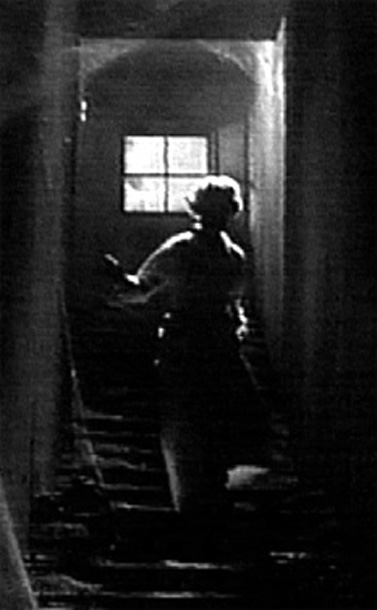The bigger they are, the harder they fall (6/21/03)
____________
The Maze. [William Cameron Menzies, 1953.]
What happens if you shoot a fairy tale and then run the film backwards: soon-to-be-newlyweds Richard Carlson and Veronica Hurst are partying happily in the south of France, chaperoned, one hopes none too effectively, by maiden Aunt and occasional narrator Katherine Emery, when out of the blue Carlson receives a telegram from the wilds of Scotland, where, apparently, his eccentric Uncle has just expired and left him a baronet. Promising he’ll be right back after settling the estate, Carlson takes off, and, well, is never heard from again. After waiting a decent interval for a reply to one of her frequent wires, Hurst [the only character in the scenario with anything resembling initiative or spunk] determines to find out just what is going on; and, Auntie reluctantly in tow, sets off for the mistenshrouded moors. Arriving on the doorstep unannounced, they prevail on the dour retainers to admit them, and find Carlson shockingly aged, withdrawn, incommunicative, unwilling to explain anything, and apparently well-launched on a project to consume the entire export quota of the native whiskey all by himself. Snooping about the nooks crannies dusty stairwells and secret passages of the ruin despite the best efforts of Carlson and his retainers to board her up in her room, Hurst finds evidence of another, mysterious, occupant, someone who for some reason leaves a trail of slime, and, naturally, disobeys the frequent insistent orders never to set foot in the picturesque garden maze laid out upon the adjacent grounds — thus, finally [this is so dumb there’s no point in not giving it away] discovering that the mysterious presence haunting the halls and hopping weirdly around the garden maze is none other than the real baronet of Castle Craven [?!], the [green] skeleton in the family closet, a mutant reminder of our amphibian ancestors who looks like, well, a giant frog. Obviously the reason everyone has been conspiring behind her back to conceal this terrifying mystery from her is that they’re afraid she’ll die laughing.
Despite Menzies’ well-deserved reputation for production design [see his famous 1936 treatment of H.G. Wells’
Things To Come], this is singularly uninspired: a castle set that might have been borrowed from Corman, the Maze itself [which could have been cool, but isn’t], and some dusty rooms where people sit around morosely drinking whiskey and glaring at one another. Everyone keeps walking in and out of the lighting setups in view of the camera, and, most annoying of all, there are a number of weirdly lopsided compositions in which the actors seem to be standing on tiptoe trying to keep their heads above the bottom of the frame while the camera takes an inexplicable interest in the ceiling. Some of this can be blamed on shooting for 3D, but not enough.
As for the unfortunate protagonist, obviously he must have been the unwitting victim of some hitherto-undiscovered conservation principle that says that every time you turn a frog into a prince, somewhere you have to turn a prince into a frog; preferably someplace like the Scottish outback, where maybe nobody will notice. — Indeed: if a frog falls from a tower window in the Highlands with no one there to see it, does it make a splat? Let me work on that and get back to you.
____________A perfectly splendid little war (4/14/03)

